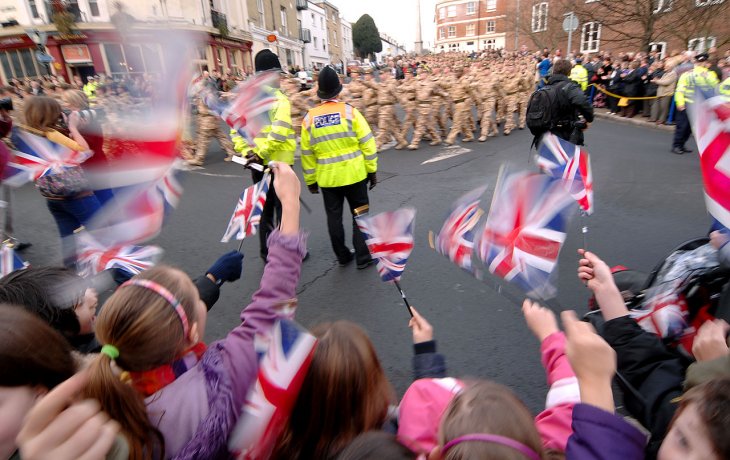By Julia Welland
In contemporary Britain, the figure of ‘The Soldier’ is increasingly visible.
S/he (although the figure is, of course, nearly always a ‘he’) appears in documentaries, in art and museum exhibitions, in Armistice Day commemorations, guarding the 2012 Olympics, in ‘boot camp’ exercise regimes, in schools, as the ‘real heroes’ of reality TV programmes such as X Factor, in charity campaigns, on food and drink packaging, and the list goes on… As the annual hand wringing over the politics (or ‘un-political’) poppy not/wearing reveals, the soldier and the job they do appears to occupy an increasingly important – and visible – role in British society.
We should care about what bodies and stories are being made visible and told and whose are being ignored.
In my latest Security Dialogue article ‘Violence and the Soldiering Body’, I argue that this increased visibility is central to how the British public came to know and understand the recent military campaign performed by the British armed forces in Afghanistan and the violence that took place. Unlike the Gulf War and Kosovo intervention in which it was the military technology as opposed to military bodies that captured the public and media’s attention, the ‘hearts and minds’ campaign of counterinsurgency in Afghanistan meant that the British (and American) public were flooded with images not of high-tech military weaponry, but a more ‘humanised’ looking war: soldiers patrolling wearing soft hats, soldiers interacting with local Afghans, and soldiers taking an active role in reconstruction efforts. The British public were also invited to ‘get to know’ these soldiers through all manner of mediums (television programmes, museum exhibitions, military memoirs…) that located not only a soldier’s potential war-fighting prowess, but also their personal traits, familial relations and even sense of humour. At the same time, the British public were confronted with the violence of the conflict through the highly public and publicized repatriations of killed soldiers and the increasing numbers of disabled and disfigured soldiers returning from the frontline – both frequently a result of the use of improvised explosive devices by the insurgent groups they were facing.

Children Welcoming Home Hampshire Troops -Photo: Cpl Adrian Harlen RLC/MOD- British National Archives Wikimedia Commons
I argue that this increased visibility of a humanised and familiar British soldier, as well as the violences they endured, has produced particular effects. First, through the continued and increased attention given to British soldiering bodies and experiences, the bodies and experiences of Afghans who have lived in and through the (on-going) conflict for sixteen years are relegated to the sidelines or ignored altogether. This includes the estimated 26,000 Afghan civilians who are thought to have died a violent death and the thousands more who have died indirectly or suffered ill health due to exacerbated effects of poverty, malnutrition, lack of sanitation and poor access to healthcare that the conflict has increased and caused. Second, that this highly visible figure of ‘The Soldier’ can often bear little resemblance to the lived experiences of those who have inhabited the role. For veterans who face homelessness, alcohol and substance abuse, or simply feel their experiences are not being heard, this hypervisibility of an idealised soldier does not reflect their own day-to-day life, either on combat operations or back in the UK on ‘civvy street.’
Just as making invisible the tens of thousands of Iraqi dead during the Gulf War and the growing numbers of civilian victims of drone strikes, when a particular body is made increasingly visible, it is likely performing important work in constructing and narrating a particular story. With Afghan civilians continuing to live through extreme violence and political uncertainty, and British veterans being confronted by diminishing state support we should care about what bodies and stories are being made visible and told and whose are being ignored.